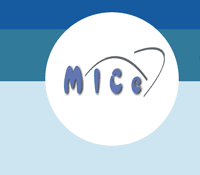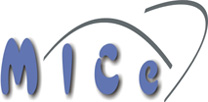 |
||||||||
 |
||||||||
|
|
||||||||
 |
 |
|||||||
THE TORONTO CENTRE FOR PHENOGENOMICS
MOUSE IMAGING CENTRE |
 |
|
|
GlossaryB mode: An ultrasonic imaging mode of operation in which a two-dimensional brightness image is produced to represent a cross-section of an object through the scanning plane. Backprojection: The process of "smearing" a projection over a reconstruction plane. An axial image of an object can be created by backprojecting many projections from various angles around the object. Diffusion weighted (DW): An imaging sequence that takes advantage of the different diffusion environments caused by tissue structure Doppler mode: An ultrasonic imaging mode of operation in which the blood flow velocity is non-invasively measured at any site of interest within the cardiovascular system, based on the Doppler effect (frequency change of a reflected sound wave as a result of reflector motion relative to the sound source). Fluorescence: Light that is emitted by a molecule soon after absorption of a higher energy photon. Fluorescent molecules can be attached to a particular type of molecule (e.g. a protein) such that the resulting fluorescent OPT image is a map of the distribution of that type of molecule throughout the object. M mode: An ultrasonic imaging mode of operation which dynamically displays the positions of the moving structures (along a single sampling line) versus time. OPT: The abbreviation of optical projection tomography. It is a new technology that uses near-infrared to ultraviolet photons and image-forming optics to create approximately parallel projections of an object that are used in a backprojection reconstruction. The spatial resolution of the system is estimated to be approximately 10 microns, with a specimen coverage of approximately 1 cubic centimetre. Radiofrequency (RF): An electromagnetic wave that has a frequency in the 10s to 100s of megahertz range Resonance: An RF pulse that is exactly at the right frequency of the spinning protons (Larmor frequency). This allows the magnetization of the object to be recorded and eventually turned into an image T1: The spin lattice relaxation time of the protons. The time it takes for the excited protons to realign with the main magnetic field. For the high fields we use, these times are on the orders of seconds for different tissues and it is difficult to get T1 contrast without the use of a contrast agent such as Gd-DTPA T2: The spin-spin relaxation time of the protons. The time it takes for the protons to diphase or become incoherent. These times are around 10-90 ms and a good contrast agent at 7 T. UBM: The abbreviation of ultrasound biomicroscopy. It is a new technology that uses very high frequency ultrasound (20~55 MHz or even higher, compared to 3~15 MHz in conventional clinical ultrasound systems) to non-invasively image the small animals in biological research. The spatial resolution of a two-dimensional image is up to ~50 μm, with penetration depth of ~20 mm. The functional modalities include B mode, M mode and Doppler mode, etc.
|
|
© 2004 The Centre for Phenogenomics |
|